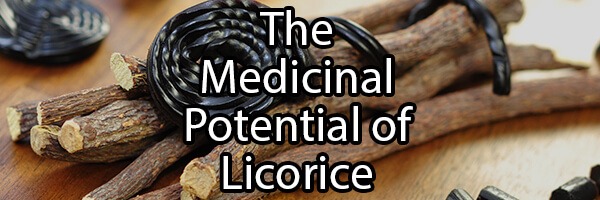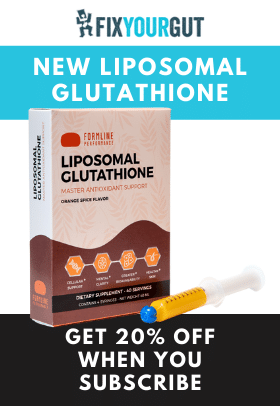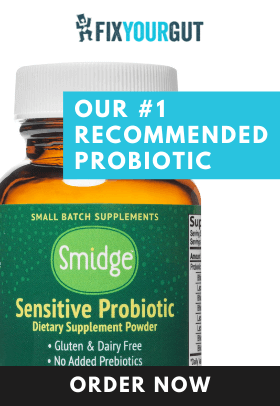Licorice (Glycyrrhiza glabra) is a prized root with demonstrated countless health benefits when used properly. Licorice can improve your gastrointestinal health, reduce bacterial dysbiosis (including H. pylori), help you to overcome viruses, reduce inflammation and pain, improve mental health, improve histamine intolerance, increase cortisol (might be useful in people who have low cortisol levels), and promote liver health. Licorice does have some drawbacks associated with its use including elevated blood pressure and water retention, which is caused by the component glycyrrhizic acid (which is removed from the supplement DGL). Licorice tastes very sweet, which is why it is used as a food additive in candy, but how can this root improve your health when used correctly?
What is Licorice and How Can it Improve Your Health?
Glycyrrhiza glabra is a herbaceous perennial legume native to southern Europe and Asia. The root of the plant (licorice) is used in food and supplement preparation. Licorice was mainly used throughout history as a candy product and flavoring in cooking. It was also used as a flavoring agent in tobacco and acts as a bronchodilator. Licorice has a lot of medicinal benefits:
- Strongly anti-inflammatory. The root contains “many natural active compounds, including more than 20 triterpenes and 300 flavonoids. Seventy three bioactive compounds and 91 potential targets are identified for this medicinal herb. Among them, 3 triterpenes, 18b-GC, 18a-GC and 18b-glycyrrhetinic acid (18b-GA), and 13 flavonoids, licochalcone A (LCA), licochalcone B (LCB), licochalcone C (LCC), licochalcone D (LCD), licochalcone E (LCE), isoliquiritigenin (ISL), echinatin (EC), glabridin (GLD), isoangustone A (ISOA), licoricidin (LID), licorisoflavan A (LIA), dehydroglyasperin C (DGC) as well as dehydroglyasperin D (DGD), all have been reported to possess anti-inflammatory activity.” Reduced production of the pro inflammatory cytokine tumor necrosis factor alpha especially when triggered by endotoxins. Reduced overactivation of the pro-inflammatory enzyme matrix metalloproteinases (calcium-dependent zinc-containing endopeptidases) which can also be triggered by an excess of endotoxins, reactive oxygen species (produced by our mitochondrial electron transport chain wherein excess causes oxidative stress), and lipid peroxidation products. Licorice also reduces overproduction of the pro-inflammatory prostaglandin, PGE2, a fever and pain inducer. Licorice can neutralize reactive oxygen species within the mitochondria and may be hepatoprotective. Inflammation is an important process for cellular repair and recovery but if triggered unnecessarily or in excess can cause more damage to the body by damaging nearby and systemic health tissue and creating excessive discomfort (increased pain and swelling for example).1
- Protects (promotes mucus production in the stomach), reduces inflammation, and heals the stomach mucosa. Relieves gastritis. 2 3
- Has been shown in studies to heal upper gut ulceration. DGL coats the ulcer, reduces inflammation, reduces H. pylori dysbiosis which is the main cause of ulcers, and increases endogenous mucus production to protect the ulcerative tissue. Finally, DGL is a prescription medication used in the treatment of ulcers in Germany.4 5
- Licorice has antimicrobial properties (inhibits Staphylococcus aureus, Escherichia coli, Pseudomonas aeruginosa, Candida albicans, and Bacillus subtilis) and inhibits H. pylori growth. Inhibition of H. pylori might be why the root works very well for stomach ulceration, gastritis, and possibly stomach cancer because pylori are reported in multiple studies as a cause of all three.6 7
- Glycyrrhizic acid a compound in licorice but removed from DGL reduces abdominal spasms, which may be useful for people with spastic colon or if you have diarrhea. “In the GI tract, mechanical experiments using GA have been performed to examine the role of gap junctions in coupling of smooth muscle cells. In these experiments, GA was reported to decrease both the amplitude and frequency of spontaneous contractions in canine ileum and colon. These findings were consistent with the hypothesis that GA uncouples gap junctions between ICCs and between ICCs and smooth muscle, which leads to a reduction in the mechanical activity of this tissue.”8
- Licorice has broad-spectrum antiviral activity. Glycyrrhizin has been shown to inhibit Hepatitis C, various Influenza strains, Herpesviridae family, Enterovirus 71, and Coxsackie A viruses. Glycyrrhizic acid has been shown to inhibit Rotavirus and human respiratory Syncytial virus.9
- Licorice is hepatoprotective and is used by IV to treat viral hepatitis and cirrhosis in Japan.10 11
- Glycyrrhizic acid increases cortisol production which may help relieve symptoms in people with sluggish adrenals, who need more cortisol.12
- Upregulates bile production and release which may improve digestion in people who suffer from sluggish bile production.13
- Gabrol and liquiritigenin are licorice components that may bind to GABAA receptors causing relaxation, improving sleep, and relieving anxiety.14
- Reduces neuroinflammation caused by endotoxins which may improve hindered cognitive function (brain fog).15
- Glycyrrhizic acid increases blood pressure and volume (might improve hypotension)16
- Upregulates Th1 (t helper cell one) differentiation at first, but decreases it over the long term by increasing glucocorticoids. Decreases Th2 (t helper cell two) differentiation, improving histamine intolerance (HIT). Relieves asthma and allergies.17 18
- Increases PTH and decreases calcium storages within the body. Increases serum calcium and calcium excretion.19
- Heals oral canker sores and reduces pain.20
The Issues Concerning Licorice Use
Though I believe in the tremendous health benefits in the proper use of licorice, it does have some side effects associated with its use because of the licorice compound glycyrrhizic acid. Glycyrrhizic acid is metabolized in the body by our microbiome, into glycyrrhetic acid. Glycyrrhizic acid, however, does have some health benefits, it can protect the liver in people with hepatitis and has antiviral properties. Glycyrrhizic acid is also used as a sweetener in food products.21 22
Glycyrrhetic acid depletes potassium in the body over time which may cause a blood pressure increase and/or arrhythmia. Also, the enzyme 11B-hydroxysteroid dehydrogenase (an enzyme that converts cortisol in the kidney to its inactivated form cortisone) is inhibited by glycyrrhetic acid increasing bio-available cortisol. It also binds directly to mineralocorticoid receptors and increases cortisol production as well. Binding of glycyrrhetic acid to the mineralocorticoid receptors causes the body to retain sodium and excrete potassium causing electrolyte imbalances that may cause arrhythmia. Licorice should be used with caution in people with elevated cortisol, chronic kidney disease, if you are prone to arrhythmia, and if you take medications that interfere with electrolyte metabolism (diuretics for example). Glycyrrhizic acid causes water retention in elevated doses or if taken long term by increasing blood pressure and volume. In some cases, this can become fatal. The use of licorice, however, may be helpful if you have low cortisol production but its use should be monitored. Proper supplementation of potassium (adrenal cocktail without salt) or adequate ingestion of dietary potassium (3,000 to 4,000 mg daily) may help reduce some of the side effects of glycyrrhetic acid causes from potassium wasting. Finally, licorice consumption may reduce testosterone production, but studies are mixed.23 24 25
“Liquorice is the root of Glycyrrhiza glabra and has been traditionally used for both its culinary and medicinal properties. Its active ingredient is glycyrrhizin which is hydrolysed in vivo to glycyrrhetinic acid. Glycerrhetinic acid inhibits 11β-hydroxysteroid dehydrogenase type 2 (11β-HSD2), an enzyme located in renal tissue that converts active cortisol to inactive cortisone. Inhibition of 11β-HSD2 results in a significant increase in cortisol concentration at the renal mineralocorticoid receptors. The consequent uncontrolled mineralocorticoid activation leads to unrestricted sodium reabsorption and potassium excretion. This results in hypertension, hypokalaemia and suppression of the renin–aldosterone axis. This pattern of an elevated blood pressure and hypokalaemia in the context of a suppressed plasma renin and aldosterone is referred to as pseudohyperaldosteronism and constitutes one of the variants of the AME syndromes. Chronic liquorice consumption may cause ongoing, though ultimately transient, suppression of the renin–aldosterone axis following discontinuation of ingestion: this may continue for up to four months. In contrast, the activity of 11β-HSD2 recovers earlier. The enzyme is suppressed for two weeks after liquorice is withdrawn and its activity increases as the urinary glycyrrhetinic acid levels decrease.“26
Finally, glycyrrhetic acid may increase your chances of developing leaky gut because it can uncouple your gut junctions by interfering with the calcium channel. When this occurs, motility decreases and intestinal cramps and spasms may lessen, which may lead to constipation. Reduced intestinal transit time or constipation may increase absorption of glycyrrhetic acid. “Prolonged gastrointestinal transit time is another factor that increases sensitivity to glycyrrhizin. The amount of glycyrrhetic acid reabsorbed depends on its transit through the small and large intestines, therefore patients with prolonged gastrointestinal transit times and more prone to toxicity after repeated intake.“27
DGL Licorice, One of the Best Supplements to Relieve Upper Gut Digestive Issues
DGL supplements have most of the glycyrrhizic acid removed and are still theorized to have most of the benefits of consuming standardized licorice for the gastrointestinal system. DGL is excellent for healing ulcerative tissue, gastritis, and preventing damage done to the mucosa by NSAID medication use. NSAID’s including ibuprofen and aspirin is one of the few non H. pylori causes of stomach ulcers and gastritis. NSAID’s harm stomach health by inhibiting COX-1 (cyclooxygenase) which hinders gastric blood flow and tissue repair. NSAIDS also thin stomach mucus by reducing the production of prostaglandins needed to stimulate stomach mucus production required to protect the lining. Since DGL improves stomach mucus production, coats the stomach, and reduces inflammation in can prevent the damage caused by NSAID’s. Finally, DGL does not impede stomach acid production, increase the pH of the stomach, or hinder gastric emptying.28 29
DGL coats the lining of the stomach reduces inflammation and its flavonoids help protect the stomach mucosal lining from excessive oxidative stress and endotoxins. Compounds in DGL licorice also regenerate stomach epithelial cells, healing the lining. DGL that is chewed well and swallowed may also help coat and protect the esophagus from endotoxin inflammation and refluxed stomach contents. DGL licorice also contains compounds glabridin and glabrene that help to reduce dysbiosis in the stomach, including H. pylori. Finally, DGL may reduce overall gastrointestinal inflammation and help improve the health of people suffering from inflammatory bowel disease.30 31 32
“On the other hand, relevant gastrointestinal effects (antiulcer activity) of G. glabra may provide noteworthy insights in understanding the pharmacological benefits in alleviation of functional dyspepsia. A double-blind clinical study on DGL exhibited ulcer healing properties upon administration of capsules (each with 400 mg actives) for 8 weeks and subjective improvements were recorded in 90% subjects. Lakworthy and Holgate reported antiulcer activity after administration of tablets containing 380 mg DGL in all the 32 patients (100%) endoscopically diagnosed having duodenal ulcer and with chronic history. The beneficial effects were found to be improved as the duration of intervention extended since 56% of the patients recovered after 12 weeks of treatment whereas 78% recuperated after 16 weeks. These findings were in accordance with the current study wherein total symptom scores and NDI were found to be improved over a period of 15 and 30 days.“33
Rarely DGL supplements can cause allergic reactions if you are allergic to licorice. I have seen it cause minor blood pressure increases in a few people, but their blood pressure went back to normal upon discontinuation of DGL. I have taken DGL myself many times of the past few years, and I have tolerated it very well. It helped improve gastritis caused by my H. pylori dysbiosis and improved the symptoms of my silent reflux. Finally, DGL or licorice root supplementation might interfere with the metabolism of the following medications:34

Overall DGL is a well-tolerated supplement:
“No treatment-related adverse effects were reported during the study, and GutGard (DGL supplement) administration was found to be safe and well tolerated by all patients during the complete intervention period.“35
Recommended DGL supplement: Vital Nutrients DGL powder
Dosage recommendations: 1/8 of a teaspoon mixed in well with two to four ounces of water, thirty minutes before breakfast, and thirty minutes before dinner. DGL powder drink must be sipped slowly and swished in the mouth to help activate many protective licorice compounds.
- https://www.ncbi.nlm.nih.gov/pubmed/27650551/ ↩
- https://www.ncbi.nlm.nih.gov/pmc/articles/PMC3818629/#ref4 ↩
- Balch, Phyllis. Prescription for Herbal Healing, Avery Publishing, 2012. ↩
- https://www.ncbi.nlm.nih.gov/pmc/articles/PMC3818629/#ref4 ↩
- Balch, Phyllis. Prescription for Herbal Healing, Avery Publishing, 2012. ↩
- https://www.ncbi.nlm.nih.gov/pmc/articles/PMC4629407/ ↩
- Balch, Phyllis. Prescription for Herbal Healing, Avery Publishing, 2012. ↩
- https://www.ncbi.nlm.nih.gov/pubmed/15528254 ↩
- https://www.ncbi.nlm.nih.gov/pmc/articles/PMC4629407/ ↩
- http://www.sciencedirect.com/science/article/pii/S2211383515000799 ↩
- https://www.ncbi.nlm.nih.gov/pmc/articles/PMC3498851/ ↩
- https://www.ncbi.nlm.nih.gov/pmc/articles/PMC3498851/ ↩
- https://www.ncbi.nlm.nih.gov/pubmed/22521565 ↩
- https://www.ncbi.nlm.nih.gov/pubmed/22543233 ↩
- http://core.kmi.open.ac.uk/display/587836 ↩
- https://www.ncbi.nlm.nih.gov/pmc/articles/PMC3498851/ ↩
- https://selfhacked.com/2014/07/17/supplements-people-th1-dominant/ ↩
- https://selfhacked.com/2014/07/18/supplements-people-th2-dominant/ ↩
- https://www.ncbi.nlm.nih.gov/pubmed/16513152 ↩
- https://www.sciencedaily.com/releases/2008/05/080522154850.htm ↩
- https://www.ncbi.nlm.nih.gov/pmc/articles/PMC3818629/#ref4 ↩
- Balch, Phyllis. Prescription for Herbal Healing, Avery Publishing, 2012. ↩
- https://www.ncbi.nlm.nih.gov/pmc/articles/PMC3818629/#ref4 ↩
- Balch, Phyllis. Prescription for Herbal Healing, Avery Publishing, 2012. ↩
- https://health.clevelandclinic.org/2013/11/how-black-licorice-can-make-your-heart-jump/ ↩
- https://www.ncbi.nlm.nih.gov/pmc/articles/PMC5298563/ ↩
- https://www.ncbi.nlm.nih.gov/pubmed/15528254 ↩
- https://www.ncbi.nlm.nih.gov/pmc/articles/PMC3818629/#ref4 ↩
- Balch, Phyllis. Prescription for Herbal Healing, Avery Publishing, 2012. ↩
- https://www.ncbi.nlm.nih.gov/pmc/articles/PMC3818629/#ref4 ↩
- Balch, Phyllis. Prescription for Herbal Healing, Avery Publishing, 2012. ↩
- https://www.ncbi.nlm.nih.gov/pmc/articles/PMC3123991/ ↩
- https://www.ncbi.nlm.nih.gov/pmc/articles/PMC3123991/ ↩
- https://www.ncbi.nlm.nih.gov/pmc/articles/PMC3889530/ ↩
- https://www.ncbi.nlm.nih.gov/pmc/articles/PMC3123991/ ↩







can i copy this article to my whatts a[[